1597 1st John Gerarde Herball Plants English Herbal Illustrated Stirpium Botany
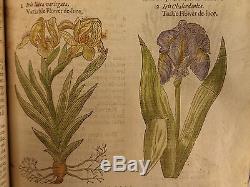

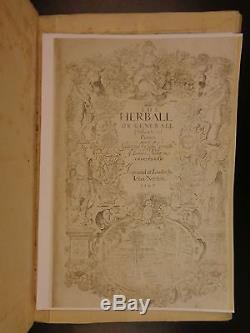
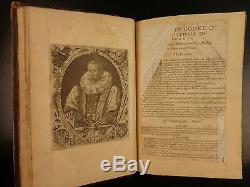
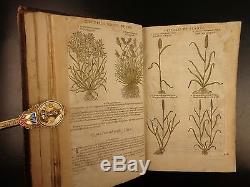
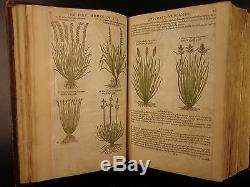
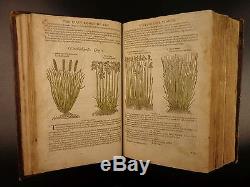
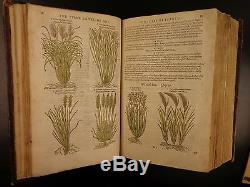
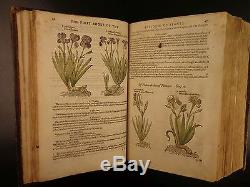
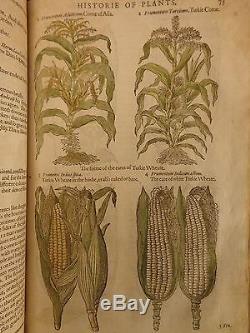
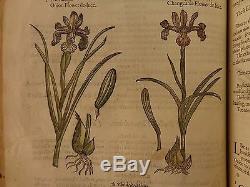
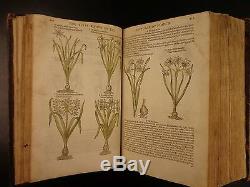


John Gerarde Herball Plants English Herbal Illustrated Stirpium Botany. John Gerard, also spelt John Gerarde, c. 15451612 was a botanist and herbalist. He maintained a large herbal garden in London.
His chief notability is as the author of a big 1484 pages and heavily illustrated Herball, or Generall Historie of Plantes. First published in 1597, it was the most widely circulated botany book in English in the 17th century. Herball, or Generall Historie of Plantes.
Was often thought to be an English translation of Dodoens Stirpium ; however, it was later discovered that Gerarde was brought in to finish the work of a Robert Priest. (see below for more thorough explanation of history). The Herball or Generall Historie of Plantes. Edition of most famous English herbal.
Lacks only the following pages. Engraved title page (replaced in facsimile). 983/984 + 19 various leaves from indices at end.The history of the production of Gerarde's Herball has not been entirely worked out. It seems that the publisher had commissioned Dr.
Robert Priest to translate Dodoens' Stirpium historiae pemptades sex (1583) into English, but that he had died before completing the task. John Gerarde was then brought in, and finished the translation, while changing the system of classification from that of Dodoens (a pharmacological one) to that of Mathias de Lobel (an attempt at a natural system), and adding notes and observations of his own. The vast majority of the woodcuts were hired from the Frankfurt publisher of Tabernaemontanus. At one point Norton brought in Lobel to correct some of Gerarde's more egregious errors (Lobel claimed to have discovered over 1000).
Gerarde's own contribution may be no more than his appealing Elizabethan prose style and his description of the'Virginian potato'. One of the few woodcuts that is original to this work is in fact the first illustration of the potato. The Tabernaemontanus cuts were based on the images of Fuchs, Brunfels, Mattioli, and the Flemish botanists published by Plantin (Dodoens, L'Écluse, and others). Interestingly, the portrait of Gerarde, who is depicted aged 53 holding a potato flower, is dated 1598.It is by William Rogers, and exists both in an unsigned state, and signed'WR' (as here). Wear as seen in photos. Tight and secure leather binding.
Lacking only a few pages as described above, but otherwise complete with all 1392 pages; plus indexes, prefaces, and such. 13in X 9in (33cm x 22.5cm). [1] He maintained a large herbal garden in London. [2] His chief notability is as the author of a big 1484 pages and heavily illustrated Herball, or Generall Historie of Plantes. Except for the additions of a number of plants from his own garden and from North America, Gerard's Herbal is largely an English translation of Rembert Dodoens's Herbal of 1554, itself also highly popular (in Dutch, Latin, French and other English translations).
Gerard's Herball is profusely illustrated with high-quality drawings of plants, with the printer's woodcuts for the drawings largely coming from Dodoens's book and from other Continental European sources, [3] but also containing an original title page with copperplate engraving by William Rogers. Two decades after Gerard's death, his Herbal was corrected and expanded to about 1700 pages. The botanical genus Gerardia is named in Gerard's honour.
Gerard was born at Nantwich, where he received his early and only schooling. Around the age of 17 he was apprenticed as a barber-surgeon. Although he claimed to have learned much about plants from travelling to other parts of the world, his actual travels appear to have been limited.
[4] In 1577, he began to supervise the London gardens of William Cecil, 1st Baron Burghley. By 1595, Gerard had become a member of the Court of Assistants in the Barber-Surgeon's Company. In 1597, he was appointed junior warden of the Barber-Surgeons, and in 1608, master of the same. Gerard was a doer, not a thinker, and an outsider in relation to the community of Lime Street naturalists in London at the time. [5] His somewhat flawed (from the perspective of some of his contemporaries) Herball is dedicated to Burghley.
Generall Historie of Plantes, p. 1,329; describing Ficus indica. In 1596, Gerard published a list of rare plants he cultivated in his own garden at Holborn, where he introduced exotic plants from the New World, including a plant he misidentified as the Yucca. The Yucca failed to bloom during his lifetime, but a pip taken from his plant later bloomed for a contemporary.
To this day Yucca bears the name Gerard gave it. A copy of the list of plants in his garden, published in 1596, exists in the British Museum. In 1597, Gerard published his famous Great Herball, or Generall Historie of Plantes. The 1597 edition reused hundreds of woodblocks from Jacobus Theodorus Tabernaemontanus Eicones Plantarum (Frankfurt, 1590), which themselves had been reused from earlier 16th-century botanical books by Pietro Andrea Mattioli, Rembert Dodoens, Carolus Clusius, and Matthias de l'Obel. Because it was a practical and useful book, packed with helpful drawings of plants, and because Gerard had a fluid and lively writing manner, his Herball was popular with ordinary literate people in 17th century England.
There is evidence of the book still being in practical use even in the early 19th century. The 1633 edition of Gerard's Herball was edited by Thomas Johnson, an apothecary and botanist who lived in London, under commission from the heirs to the estate of John Gerard. His edition contained many corrections and new information based on empirical observation. Through anecdotal comments, Johnson carefully distanced himself from the original work. For example, he wrote of the entry on the saffron crocus, Our author in this chapter was of many minds.Gerard can be considered one of the founders of botany in English language, but he was not well educated, and he was not an outstanding botanist in terms of technical knowledge in his own time according to his critics. The art of describing the natural world through direct observation divides Renaissance natural historians from their medieval predecessors, whose practitioners were largely uncritical adherents of the ancient texts. The earliest printed works in Renaissance natural history fell into two categories: 1. Newly recovered, translated and corrected editions of ancient texts, and 2.
Herbals based on the empirical knowledge of the early botanists. Although Francis Bacon advocated inductive thinking based on observation or description (empiricism) as the way to understand and report on the natural world, the early Renaissance printed herbals were slightly modified adaptations of the works of their medieval predecessors.Generally, these somewhat unscientific early scientists contented themselves with listing plants and occasionally other things like animals and minerals, and noting their medical uses. John Gerard worked within the early wave of Renaissance natural historians, who sought to systematize natural history while retaining the works of the ancients. [11] The basis for Gerard's Herball, like those of Dodoens and other herbalists, was the De Materia Medica of Dioscorides, an early Greek writer whose work was considered a definitive text, as well as the works by Gerard's contemporaries, the German botanists Leonard Fuchs, after whom Fuchsia is named, and the Flemish botanist Matthias de l'Obel or Lobelius, after whom Lobelia is named. Both Fuchs and L'Obel were early botanists who worked empirically with plants. They were well educated, as were other members of the "Lime Street community" in the City of London.
Gerard and L'Obel were friends who made occasional field trips together, although Gerard, who was less well-educated and lived in the suburb of Holborn, was considered an outsider by the Lime Street community. "The Nutmeg with his Mace about him", page from The Herball, or, Generall Historie of Plantes, 1633. The origins of Gerard's Herball, famous for its detailed (if sometimes inaccurate) descriptions of plants, as well as the folklore contained in the articles regarding natural phenomena and its splendid prose and prints, are somewhat controversial. The Queen's printer John Norton had commissioned a Dr Priest to prepare an English-language translation of Rembert Dodoens' immensely popular herbal, but Priest died before completing the work.
Norton, the eventual publisher of the Herball, then asked John Gerard to take over the work. Gerard finished the translation, rearranging the work, and adding as-yet-unpublished material from his friend, the herbalist L'Obel. However, in the herbal, Gerard states that Priest's translation had disappeared and that he had written a new book. Modern-day authorities disagree as to how much of Gerard's Herball was original. James Garret, a Huguenot apothecary living and working in London, and a neighbour of L'Obel, made a chance visit to the Norton publishing shop, where he discovered the proofs of the Herball, and alerted the Nortons as both to errors he discovered in the proofs and to the incorporation of some of L'Obel's material in Gerard's new book. Although they were not concerned about plagiarism, the Nortons, fearing errors in a book that was supposed to be an expert reference guide, hired L'Obel, an internationally recognized expert on plants (who had as Gerards friend, unwittingly contributed to his book) to proof the translations, fix the mismatched illustrations, and right its textual wrongs. When Gerard discovered L'Obel's thankless efforts, he had him dismissed. Later, Gerard was accused by L'Obel of plagiarizing a translation of Dodoens' work for his Herball. Despite some shortcomings in Gerards effort, Linnaeus honored him in the name of the plant genus Gerardia. Gerards Herball references many of the poisonous plants mentioned in Shakespeares plays. Additional value has been placed on the Herball by students of literature. For example, the herb which produces the deathlike sleep of Juliet or Cymbeline may refer to Nightshade, Mandragora or Doronicum, all of them listed and described in the Herball. The standard author abbreviation J. Gerard is used to indicate this individual as the author when citing a botanical name. The item "1597 1st John Gerarde Herball Plants English Herbal Illustrated Stirpium Botany" is in sale since Tuesday, May 10, 2016. This item is in the category "Books\Antiquarian & Collectible". The seller is "schilb_antiquarian_books" and is located in Columbia, Missouri. This item can be shipped worldwide.- Binding: Leather
- Subject: Science & Medicine
- Topic: Biological Science
- Special Attributes: 1st Edition
- Origin: English
- Original/Reproduction: Original
- Year Printed: 1597
- Printing Year: 1597


